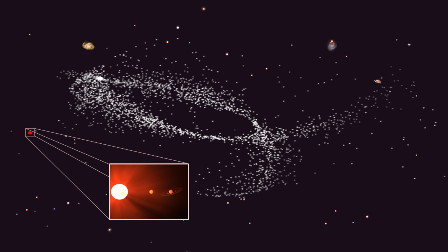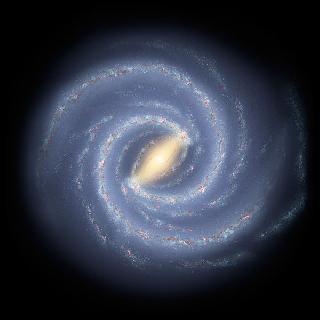
An artist's impression of the Red Dwarf Kapteyn's star superimposed on a diagram showing its ejection from a nearby dwarf galaxy. An RAS image
WASHINGTON (PTI): Scientists have discovered two new planets orbiting an ancient star near our Sun and one of them may have liquid water on its surface, a key ingredient to support life.
An international team of astronomers studied Kapteyn's Star, the second fastest-moving star in the sky, which is only 13 light years away from Earth.
The astronomers used new data from the HARPS spectrometer at the European Southern Observatory's La Silla observatory, the Planet Finding Spectrometer at the Magellan/Las Campanas Observatory in Chile, and the HIRES spectrometer at Keck Observatory in Hawaii to measure tiny periodic changes in the motion of the star.
The Doppler Effect enabled the scientists - including Carnegie Institution's Pamela Arriagada, Paul Butler, Steve Shectman, Jeff Crane, and Ian Thompson - to deduce some properties of these planets, including their masses and orbital periods.
"We were surprised to find planets orbiting Kapteyn's star. Previous data showed some irregular motion so we were looking for very short period planets when the new signals showed up loud and clear," said lead author Dr Guillem Anglada-Escude, a former Carnegie postdoc now at the Queen Mary University of London.
Researchers said one of the planets, called Kapteyn b, is orbiting the star at the right distance to allow liquid water to exist on its surface.
The planet is at least five times the mass of that of Earth and orbits its star every 48 days. This means the planet is warm enough for water to be present on its surface.
The second planet, Kapteyn c is a more massive super-Earth in comparison. Its year lasts for 121 days and astronomers think it's too cold to support liquid water.
Kapteyn's Star is the 25th nearest star to the Sun - only 13 light years away from Earth. Kapteyn's Star is thought to have been born in a dwarf Galaxy that was long ago disrupted and absorbed by the Milky Way.
This galactic cannibalisation set the star on a new path, making it part of the Milky Way's halo.
The likely remnant core of the original dwarf galaxy is Omega Centauri, an enigmatic group of stars 16,000 light years from Earth that contains hundreds of thousands of similarly old suns and was long thought to be a globular cluster.
This sets the most likely age of Kapteyn's Star and its planets at 11.5 billion years, which is 2.5 times older than Earth and "only" 2 billion years younger than the Universe itself (which has been measured to be 13.7 billion years old).
The study was published in the Monthly Notices of the Royal Astronomical Society.
 Previous Article
Previous Article Next Article
Next Article












The Indian Air Force, in its flight trials evaluation report submitted before the Defence Ministry l..
view articleAn insight into the Medium Multi-Role Combat Aircraft competition...
view articleSky enthusiasts can now spot the International Space Station (ISS) commanded by Indian-American astr..
view article